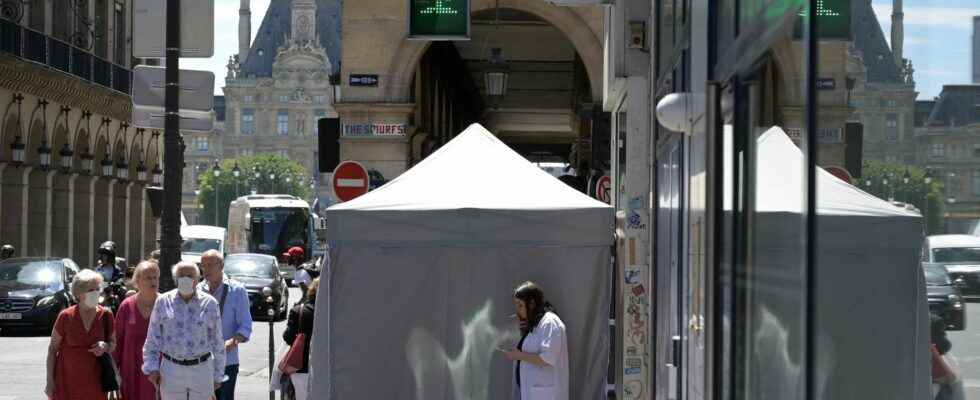The health sky is clearing and the epidemiological counters are turning green again. In recent days, France has fallen below the bar of 5,000 positive cases per day. Unheard of since October 2021. “There has been a sharp decline in the epidemic for several weeks, even if it is true that the population is doing fewer tests than during previous waves”, advances to L’Express Yannick Simonin, professor of virology at the University from Montpelier. In total, 70,000 French people carry out a Covid test (PCR or antigenic) every day on average, reports CovidTracker. A very low figure compared to the 200,000 people who were screened daily last December.
According to the latest CoviPrev survey, published on December 22, 23% said they had had symptoms of Covid-19 since September 2022. Among them, 79% had taken a screening test compared to 26% among respondents who had not presented symptoms of Covid-19 since September 2022. For 23%, they were “not worried” about being infected with the virus. Three years after the start of the pandemic, the French seem to be relaxing their vigilance. If the epidemic is not behind us yet, should we review our screening strategy? “France has never had serious strategies for using tests. On the contrary, we have been in excess”, answers Yves Buisson, epidemiologist and president of the “Covid epidemic” monitoring unit.–19″ at the National Academy of Medicine.
According to the expert, the tests remain “perfectly indicated”, but he questions the usefulness of screening tests, “carried out by people who do not have symptoms.” “It is not thanks to the tests that we have been able to build the epidemiological surveillance of Covid-19”, considers Yves Buisson. The decline of the ninth wave in France raises various questions about the behavior to be adapted: should we be tested if we are in contact? “When a person is symptomatic, they have to go get tested. For contact cases, it depends on the situation and if you plan to see vulnerable people around you,” explains Yannick Simonin. In other words, we must bet on the individual responsibility of the population.
“We must organize viral surveillance”
Epidemiologist Antoine Flahault, director of the Geneva Institute of Global Health, made a similar speech last January in the columns of L’Express: “The estimate of the number of contaminations can no longer be based on broad testing of cases. and their contacts, because it represents exorbitant costs that could be invested elsewhere, for poor quality, since a large number of infections go undetected.” Beyond the economic cost, is it still useful to communicate the number of cases on a daily basis? Indeed, people are testing themselves less and less, which can skew these figures and call into question, in the long term, their relevance. In Great Britain there is a policy of testing on a sample of the population which makes it possible to better understand the circulation of the virus. For its part, Spain has decided to end Covid-19 tests and full monitoring of the disease.
In The Parisian, this Tuesday, the Ministry of Health said it was considering how to “best adapt the strategy while preserving the need for epidemic surveillance”. From there to test less to test better? “We must organize viral surveillance, that is to say genomic surveillance of the viruses that circulate. It is important at a time when we do not know whether there will be a tenth wave or not”, insists Christine Rouzioux, professor emeritus of virology at the Faculty of Medicine of Necker and member of the Academy of Medicine. However, sequencing implies being able to test enough people. For the specialist, it is necessary to detect as well as possible on the basis of well-monitored indicators, in particular by relying on the results of laboratories and city doctors.
“The trio of city medicine, hospitals and laboratories is the basis for monitoring the circulation of the virus. In the event of signals, the viruses must be sequenced”, notes Christine Rouzioux. Less massive surveillance, but more targeted and fine-tuned. Same story on the side of Yannick Simonin. He too supports the importance of epidemic monitoring at the level of sequencing: “We must bring up positive cases and sequence them in order to have a regular photograph of the variants circulating in Europe.” The stated objective is clear: to continue to be able to quickly observe the arrival of a variant that is more contagious or even escapes the immune system more. “In France, we are able to sequence between 2,000 and 4,000 sequences per week, which can give a good picture of the variants circulating”, he continues.
Combined tests, “a good diagnostic tool”
In addition, the future of infectious disease surveillance could also lie in combined tests for influenza, Covid-19 and respiratory syncytial virus (RSV), responsible in particular for bronchiolitis in children. Three tests in the space of 15 minutes. Like Covid-19 alone, there are two types of tests: antigens and PCR. Note that the triple PCR tests work exactly like a Covid PCR. Tests which already exist, but which should be further promoted according to Yannick Simonin: “The logic is to go towards these combined tests if their reliability is proven. Some are still being evaluated, there is no clear recommendation at this level. Faced with the co-circulation of viruses, I think it is a good diagnostic tool.” Seized at the end of 2022 by the Ministry of Health, the High Authority for Health must soon decide on combined tests, in particular about the possible reimbursement of these tests.
